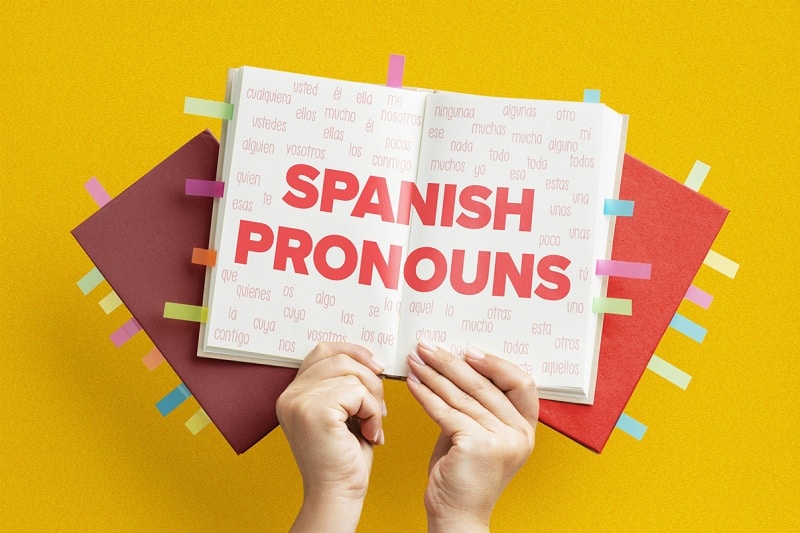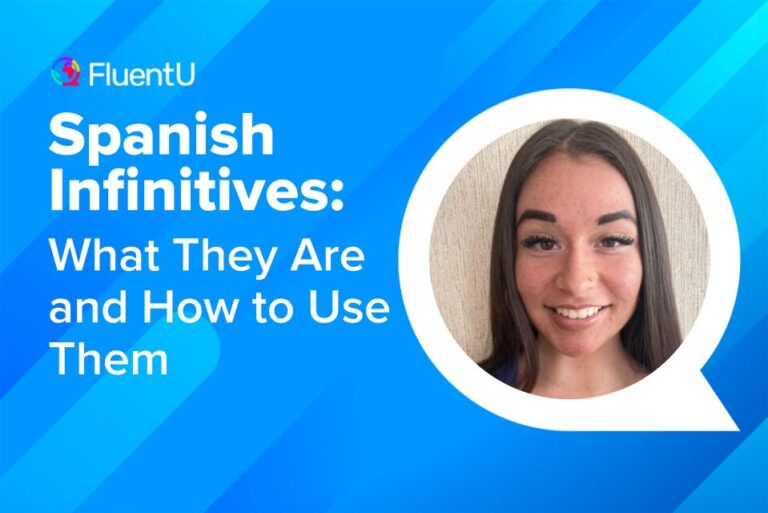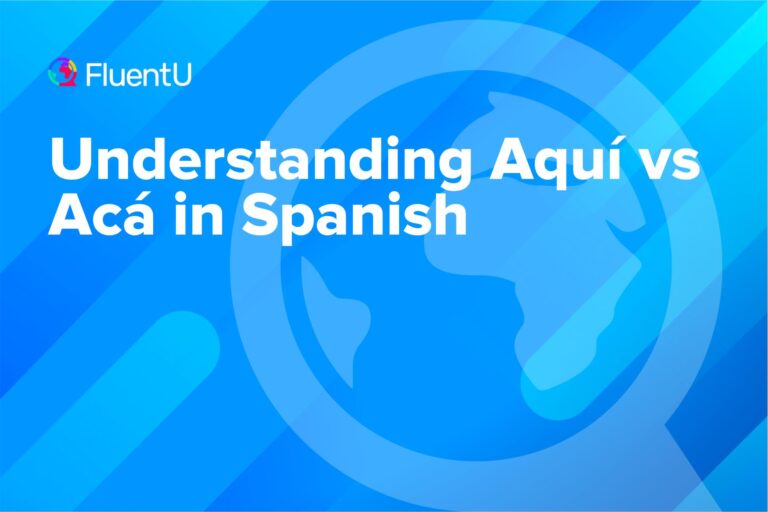Contents
- What Are Spanish Pronouns?
- Different Types of Spanish Pronouns
- Pronoun Placement in a Sentence
- Where to Place Subject Pronouns
- Where to Place Direct Object Pronouns
- Where to Place Indirect Object Pronouns
- Where to Place Reflexive Pronouns
- Where to Place Pronouns with Infinitives
- How to Use Pronouns with Gerunds
- How to Use Pronouns with Commands
- How to Use Pronouns with Compound Verbs
- How to Avoid Confusion with Pronoun Placement
- How to Use Pronouns Together
- Subject Pronoun Omission
- Gender with Spanish Pronouns
- Formality with Spanish Pronouns
- How to Practice Spanish Pronouns
- And One More Thing…
Spanish Pronouns and How to Use Them

Pronouns are words that replace nouns, helping us avoid repetition and make sentences clearer. In Spanish, pronouns are especially important because they reflect details like gender, number, and formality.
This guide will introduce you to the nine types of Spanish pronouns and how to use them effectively.
Download: This blog post is available as a convenient and portable PDF that you can take anywhere. Click here to get a copy. (Download)
What Are Spanish Pronouns?
Pronouns are small words that take the place of nouns and make things more concise, so you don’t have to continue saying someone’s name over and over again.
For example, instead of saying:
Juan es alto. Juan es guapo.
(Juan is tall. Juan is handsome.)
We can instead say:
Juan es alto. Él es guapo.
(Juan is tall. He is handsome.)
There are nine types of Spanish pronouns:
- Subject pronouns
- Possessive pronouns
- Direct object pronouns
- Indirect object pronouns
- Prepositional pronouns
- Reflexive pronouns
- Relative pronouns
- Indefinite pronouns
- Demonstrative pronouns
Let’s explore each of them in-depth now.
Different Types of Spanish Pronouns
1. Subject Pronouns
| English Pronoun | Spanish Pronoun | Example Sentence |
|---|---|---|
| I | Yo | Yo estoy estudiando.
(I am studying.) |
| You (singular, informal) | Tú | Tú eres muy inteligente.
(You are very intelligent.) |
| You (singular, formal) | Usted | Usted es muy amable.
(You are very kind.) |
| He | Él | Él trabaja en un banco.
(He works at a bank.) |
| She | Ella | Ella canta muy bien.
(She sings very well.) |
| We | Nosotros | Nosotros vamos al cine.
(We are going to the movies.) |
| You (plural) | Ustedes | Ustedes son mis amigos.
(You all are my friends.) |
| You (plural, masculine, Spain) | Vosotros | Vosotros sois mis mejores amigos.
(You all are my best friends.) |
| You (plural, feminine, Spain) | Vosotras | Vosotras estáis organizando la fiesta.
(You all are organizing the party.) |
| They (masculine) | Ellos | Ellos están estudiando para el examen.
(They are studying for the exam.) |
| They (feminine) | Ellas | Ellas son muy talentosas.
(They are very talented.) |
The subject of a sentence is the person, place or thing that is linked to your main verb. It’s the most important noun in your sentence.
Take the phrase Juan es alto (Juan is tall).
Juan is our subject and es (from ser) is our verb.
To avoid repeating the name of our person, place or thing (in this case, Juan) over and over again, we use a subject pronoun to replace it.
This post can show you more about Spanish subject pronouns, but here are some main points to keep in mind:
- You may have noticed that Spanish has more than one type of “you.” There’s a difference between formal and informal as well as singular versus plural, which you can read about here if you’re not familiar
- Also, be careful that you add the accent to él and tú: this way, you’ll say “he” instead of “the” (el), and “you” instead of “your” (tu)
- Spanish also has some pronouns to say the word “it,” however they are very rarely used. But for the sake of completeness, they are: él (“it” masculine), ella (“it” feminine) and ello (“it” neutral)
2. Direct Object Pronouns
| English Pronoun | Spanish Pronoun | Example Sentence |
|---|---|---|
| Me | Me | Mi mamá me llamó.
(My mom called me.) |
| You (singular, informal) | Te | Te vi en el parque.
(I saw you in the park.) |
| Him / it (masculine) | Lo | Lo conozco desde hace mucho tiempo.
(I have known him for a long time.) |
| Her / it (feminine) | La | Vi a María en el parque. La saludé.
(I saw María in the park. I greeted her.) |
| Us | Nos | Nos invitaron a la fiesta.
(We were invited to the party.) |
| You (plural, informal, Spain) | Os | Os vi en la tienda.
(I saw you all in the store.) |
| You / them (plural, masculine) | Los | Los escuché cantar.
(I heard you all singing.) |
| You / them (plural, feminine) | Las | Las entregué esta mañana.
(I delivered them this morning.) |
To understand this type of pronoun, we need to know what the object of a sentence is.
Remember that the subject of a sentence is the person, thing or place that is directly linked to the verb. Well, the object of the sentence is the thing or person that receives the action of the subject.
So in the example “Juan hit the ball” (Juan golpeó la bola), Juan is the subject and the ball is the object.
Again, to avoid repetition, we often use a direct object pronoun.
In English, these are the same as the prepositional object pronouns, which is why English speakers often mix up the two in Spanish.
So, let’s say we ask where the ball is:
¿Dónde está la bola?
We then can answer using a direct object pronoun, since the speaker already knows we are referring to the ball:
Juan la tiene. (Juan has it.)
This is easier than saying “Juan tiene la bola.” Note that the direct object pronoun goes before the verb, not afterwards (another common mistake English speakers make!).
If we’re talking about something masculine, not feminine, like a book, for example, then we need to use the masculine pronoun: lo.
So if Diego has the book, we could say, “Diego lo tiene.” (Diego has it.) If Diego has more than one book, we make our pronoun plural: Diego los tiene. (Diego has them.)
3. Indirect Object Pronouns
| English Pronoun | Spanish Pronoun | Example Sentence |
|---|---|---|
| To me | Me | Mi mamá me dio un regalo.
(My mom gave me a gift.) |
| To you | Te | Te presté mi libro.
(I lent you my book.) |
| To him/her/it | Le | Le dije la verdad.
(I told him/her the truth.) |
| To us | Nos | Nos entregaron el paquete.
(They gave us the package.) |
| To you | Os | Os he hecho la cena.
(I have made dinner for you.) |
| To you/them | Les | Les di las llaves.
(I gave them the keys.) |
An indirect pronoun tells us where the direct object is going (to whom?/for whom?).
Let’s look at the sentence: “Juan gives the ball to Laura.” (Juan da la bola a Laura).
What’s our subject? Juan.
What’s our direct object? The ball.
And where is our direct object going? To Laura. So she must be our indirect object!
In some sentences, our direct object isn’t explicit, like in the sentence, “Diego le contó” (Diego told her/him). We have both a subject (Diego) and an indirect object (her/him), but we don’t know what the direct object is.
We have to assume that the answer is “it,” or a juicy secret about Juan.
4. Prepositional Object Pronouns
| English Pronoun | Spanish Pronoun | Example Sentence |
|---|---|---|
| Me | Mí | Este regalo es para mí.
(This gift is for me.) |
| You (singular, informal) | Ti | Estoy pensando en ti.
(I'm thinking of you.) |
| You (singular, formal) | Usted | La reunión es importante para usted.
(The meeting is important for you.) |
| Him | Él | Habló de él durante la conferencia.
(He talked about him during the conference.) |
| Her | Ella | Él salió a cenar con ella.
(He went out for dinner with her.) |
| It | Él/Ella | Amo este libro, no puedo vivir sin él.
(I love this book, I can't live without it.) |
| Us | Nosotros | Llamaron a un Uber para nosotros porque era tarde.
(They called an Uber for us because it was late.) |
| You (plural) | Ustedes | Organizamos una fiesta sorpresa para ustedes.
(We organized a surprise party for you all.) |
| You (plural, masculine, Spain) | Vosotros | Tengo algo para vosotros.
(I have something for you all.) |
| You (plural, feminine, Spain) | Vosotras | No puedo esperar a irme de vacaciones con vosotras.
(I can't wait to go on vacation with you.) |
| Them (masculine) | Ellos | Yo fui a la playa sin ellos.
(I went to the beach without them.) |
| Them (feminine) | Ellas | Vamos de compras con ellas.
(We are going shopping with them.) |
These pronouns are used after prepositions such as for, with, from, without, etc.
A quick note on mí: it’s important to remember the accent on this word or you’ll be saying mi (my) instead. Mí also often gets confused with yo as Spanish uses “I” and “me” differently than English.
For example, if a teacher asked:
Alguien robó mi libro, ¿quién fue?
(Someone has stolen my book, who was it?)
The perpetrator should say “Yo” (I) and not mí (me).
Another rule to remember is that after the preposition con, the rules change ever so slightly:
Con mí → conmigo
Con ti → contigo
For example, “Come with me” would be “Ven conmigo,” and “He wants to go with you” would be “Él quiere ir contigo.“
5. Reflexive Pronouns
| English Pronoun | Spanish Pronoun | Example Sentence |
|---|---|---|
| Myself | Me | Me cepillo los dientes todas las mañanas.
(I brush my teeth every morning.) |
| Yourself (singular, informal) | Te | Te lavas las manos antes de comer.
(You wash your hands before eating.) |
| Yourself (singular, formal) | Se | Se peina el cabello todos los días.
(You brush your hair every day.) |
| Himself / herself / itself | Se | Se mira en el espejo.
(He/She looks at himself/herself in the mirror.) |
| Ourselves | Nos | Nos ayudamos mutuamente.
(We help each other.) |
| Yourselves (plural) | Se | Se cuidan mucho.
(You all take care of yourselves.) |
| Yourselves (plural, informal, Spain) | Os | Os peináis antes de salir.
(You all comb your hair before going out.) |
| Themselves | Se | Se visten elegantemente.
(They dress themselves elegantly.) |
Reflexive verbs are a common source of grievance for beginners as they add an extra dimension to the verb, but they are actually pretty simple.
For example, when you say, “Se llama Diego” (His name is Diego), you are using the reflexive verb llamarse (to call oneself).
Reflexive verbs always end in –se in the infinitive. When you conjugate the verb, you need to drop the se from the end of the verb, and put it before the verb.
You may or may not change the se to another reflexive pronoun, depending on who you’re talking about.
Think back to some of those first Spanish verbs you ever learned, like:
- vestirse (to dress oneself, aka to get dressed)
- peinarse (to brush/to comb oneself)
- ducharse (to shower/to shower oneself).
You might say something like:
Me ducho por las mañanas antes de vestirme.
(I take a shower in the morning before I get dressed)
You would be using reflexive pronouns without even realizing it.
6. Relative Pronouns
| English Pronoun | Spanish Pronoun | Example Sentence |
|---|---|---|
| Who / that (singular) | Que | El hombre que está hablando es mi hermano.
(The man who is speaking is my brother.) |
| Who / that (plural) | Que | Los alumnos que estudian mucho tienen buenas notas.
(The students who study a lot have good grades.) |
| Whom | A quien | Él es el hombre a quien saludé.
(He is the man whom I greeted.) |
| Which | Que | Este es el libro que me recomendaste.
(This is the book which you recommended to me.) |
| Whose | Cuyo | El hombre cuyo coche se averió llamó a una grúa.
(The man whose car broke down called a tow truck.) |
| That | Que | Los amigos que están aquí son muy divertidos.
(The friends who are here are very fun.) |
Relative pronouns are words or phrases that refer back to a noun previously mentioned.
In English, they’re words like “who,” “whom,” “whose,” “which,” “that,” “what,” “where” and “when.”
Note that some of these change based on gender and number.
Also, it’s not possible to omit the relative pronoun in Spanish. In English, you could say “The car (that) you crashed was new.” In Spanish, you cannot omit the “that,” and you have to say:
El auto que chocaste era nuevo.
More on these pronouns can be found here.
7. Possessive Pronouns
| English Pronoun | Spanish Pronoun (Singular) | Spanish Pronoun (Plural) | Example Sentence |
|---|---|---|---|
| Mine (masculine) | Mío | Míos | El libro es mío.
(The book is mine.) Los libros son míos. (The books are mine.) |
| Mine (feminine) | Mía | Mías | La casa es mía.
(The house is mine.) Las casas son mías. (The houses are mine.) |
| Yours (masculine) | Tuyo | Tuyos | El coche es tuyo.
(The car is yours.) Los coches son tuyos. (The cars are yours.) |
| Yours (feminine) | Tuya | Tuyas | La bicicleta es tuya.
(The bicycle is yours.) Las bicicletas son tuyas. (The bicycles are yours.) |
| His / hers (masculine) | Suyo | Suyos | El perro es suyo.
(The dog is his/hers.) Los perros son suyos. (The dogs are his/hers.) |
| His / hers (feminine) | Suya | Suyas | La flor es suya.
(The flower is his/hers.) Las flores son suyas. (The flowers are his/hers.) |
| Ours (masculine) | Nuestro | Nuestros | El proyecto es nuestro.
(The project is ours.) Los proyectos son nuestros. (The projects are ours.) |
| Ours (feminine) | Nuestra | Nuestras | La empresa es nuestra.
(The company is ours.) Las empresas son nuestras. (The companies are ours.) |
| Yours (masculine) | Vuestro | Vuestros | El regalo es vuestro.
(The present is yours.) Los regalos son vuestros. (The presents are yours.) |
| Yours (feminine) | Vuestra | Vuestras | La carta es vuestra.
(The letter is yours.) Las cartas son vuestras. (The letters are yours.) |
| Theirs / yours (masculine) | Suyo | Suyos | El sombrero es suyo.
(The hat is theirs/yours.) Los sombreros son suyos. (The hats are theirs/yours.) |
| Theirs / yours (feminine) | Suya | Suyas | La llave es suya.
(The key is theirs/yours.) Las llaves son suyas. (The keys are theirs/yours.) |
Possessive pronouns have four forms: the masculine and feminine forms in both plural and singular.
They are always used with the definite article “the” (el, la, los, las).
The possessive pronouns work much like their English counterparts, so in answer to:
¿De quién es este auto?
(Whose car is this?)
You might say:
Es mío.
(It’s mine.)
Or:
Es nuestro.
(It’s ours.)
The form of the possessive pronoun must match the noun it’s replacing. So in the above example, the noun we are talking about is el auto, which is why the possessive pronoun is singular and masculine.
Be careful not to mix up possessive pronouns with possessive adjectives, which mean the same as the possessive pronouns in English: my, your, his/her/its/ours/yours/theirs, but are slightly different in Spanish.
For example, “My girlfriend is pretty” translates to:
Mi novia es guapa.
In this case, “my” is a possessive adjective because it describes a noun (girlfriend).
Now if you say “La tuya no es guapa.” (Yours isn’t pretty), “yours” takes the place of “girlfriend” and uses a possessive pronoun.
This post can show you even more about possessive pronouns.
8. Indefinite Pronouns
| English Pronoun | Spanish Pronoun | Example Sentence |
|---|---|---|
| Everyone | Todos / todas | Todos están invitados a la fiesta.
(Everyone is invited to the party.) |
| Someone | Alguien | Alguien llamó a la puerta.
(Someone knocked on the door.) |
| Anyone | Alguien | ¿Hay alguien aquí?
(Is there anyone here?) |
| Anyone | Cualquiera | Cualquiera puede hacer eso.
(Anyone can do that.) |
| Nobody | Nadie | Nadie conoce la respuesta.
(Nobody knows the answer.) |
| Everybody | Todos / todas | Todos están disfrutando del concierto.
(Everybody is enjoying the concert.) |
| Something | Algo | Hay algo en la caja.
(There is something in the box.) |
| Anything | Algo | ¿Quieres algo de beber?
(Do you want anything to drink?) |
| Nothing | Nada | No hay nada en la mesa.
(There is nothing on the table.) |
| Each one | Cada uno / cada una | Cada uno tiene su propia opinión.
(Each one has their own opinion.) |
| Many | Muchos / muchas | Muchos vinieron a la reunión.
(Many came to the gathering.) |
| Few | Pocos / pocas | Pocos saben la verdad.
(Few know the truth.) |
| Several | Varios / varias | Varios están interesados en el proyecto.
(Several are interested in the project.) |
Indefinite pronouns are pronouns where the thing we’re talking about isn’t clear.
In English, they are words like “somebody,” “nobody” and “anybody.” In Spanish, they’re the same, just translated.
If you want to know more about indefinite pronouns, check out this post.
9. Demonstrative Pronouns
| English Pronoun | Spanish Pronoun (Masculine) | Spanish Pronoun (Feminine) | Example Sentence |
|---|---|---|---|
| This | Este | Esta | Este es interesante.
(This is interesting.) |
| These | Estos | Estas | Estos son interesantes.
(These are interesting.) |
| That | Ese | Esa | Ese es grande.
(That is big.) |
| Those | Esos | Esas | Esos son grandes.
(Those are big.) |
| That (over there) | Aquel | Aquella | Aquel es antiguo.
(That over there is old.) |
| Those (over there) | Aquellos | Aquellas | Aquellos son antiguos.
(Those over there are old.) |
The only other type of pronoun that you could possibly need are demonstrative pronouns.
These are the equivalent of “this/that/these/those one/s” in English.
These demonstrative pronouns are the same as the demonstrative adjectives, but they replace, rather than describe a noun.
Other demonstrative pronouns that don’t change according to gender or whether they’re plural are esto (this matter/this thing), eso (that matter or that thing) and aquello (that matter/thing over there).
For example, you might say:
Esto es muy difícil.
(This is very difficult.)
Pronoun Placement in a Sentence
You might know all the pronouns but they won’t be of any use to you if you don’t know where to stick them in a sentence. Here are some ground rules for pronoun placement in Spanish:
Where to Place Subject Pronouns
Subject pronouns can be omitted entirely—they’re typically used for emphasis or clarification, as the verb conjugation already indicates the subject. They usually come before the verb.
Example:
Yo hablo español.
(I speak Spanish.)
Where to Place Direct Object Pronouns
Direct object pronouns replace the direct object of a verb and are placed before the verb.
Example:
Lo vi ayer.
(I saw him yesterday.)
Where to Place Indirect Object Pronouns
Indirect object pronouns replace the indirect object of a verb and also show up before the verb.
Example:
Le dije la verdad.
(I told him/her the truth.)
Where to Place Reflexive Pronouns
Reflexive pronouns indicate that the subject performs the action on themselves. They generally come before the verb.
Example:
Me lavo las manos.
(I wash my hands.)
Where to Place Pronouns with Infinitives
When a pronoun is used with an infinitive verb (that is, an unconjugated one), it can either be attached to the end of the infinitive or placed at the beginning of the sentence.
Example:
Voy a hacerlo.
/ Lo voy a hacer.
(I am going to do it.)
How to Use Pronouns with Gerunds
When a pronoun is used with a gerund (the “-ing” form of a verb), it can either be attached to the end of the gerund or placed before it.
Example:
Estoy leyéndolo.
/ Lo estoy leyendo.
(I am reading it.)
How to Use Pronouns with Commands
When a pronoun is used with an affirmative command, it’s attached to the end of the verb. For negative commands, it’s placed before the verb.
Example:
Hazlo.
(Do it.) or No lo hagas.
(Don’t do it.)
How to Use Pronouns with Compound Verbs
When a verb is formed with an auxiliary verb and a main verb, the pronoun is usually placed before the auxiliary verb.
Example:
Me han dicho.
(They have told me.)
How to Avoid Confusion with Pronoun Placement
To avoid confusion or ambiguity, Spanish allows the use of redundant pronouns. This means that both the pronoun and the noun can be used together in a sentence.
Example:
El libro, yo lo leí.
(The book, I read it.)
It’s important to note that there are additional rules and exceptions depending on the specific verb tense, mood and structure of the sentence.
How to Use Pronouns Together
What happens if you have both an indirect and a direct object in one sentence? Look at this example:
She gave it to you.
Our subject is “she,” our object is “it” and our indirect object is “you.”
In Spanish, the direct and indirect object must always be placed side by side, with the indirect object first. So in Spanish, the sentence would be:
Ella te lo dio.
We couldn’t say, for example, Ella te dio lo, nor Ella lo te dio.
Things get just slightly modified when you have two pronouns that begin with “l.”
For example, ella les lo dio (she gave it to them) is too much of a mouthful for anyone to bear. But whenever both pronouns begin with “l,” change the first one (the indirect pronoun) to se:
Ella les lo dio → Ella se lo dio.
Here are a few more tips:
1. Pronoun Order: In Spanish, the order of pronouns in a sentence is typically as follows: reflexive pronoun → indirect object pronoun → direct object pronoun (me, te, lo/la, nos, os, los/las).
Example:
Me lo dio. (He gave it to me.)
2. Indirect and Direct Object Pronoun Placement: When using both an indirect object pronoun and a direct object pronoun together in a sentence, the indirect object pronoun generally comes before the direct object pronoun.
Example:
Él me lo dijo. (He told it to me.)
Subject Pronoun Omission
As I mentioned earlier, it’s pretty normal to hear someone in Spanish say a sentence that starts with the verb and doesn’t have a pronoun.
This is because pronouns are sort of seen as irrelevant for the most part—you (usually) know who the subject is based on the verb conjugation.
In fact, it sounds a bit strange if you include pronouns in every single sentence that you say. Especially when it comes to yo, because saying “I” over and over can come across as a bit self-important.
Just remember that you don’t need a subject pronoun to be grammatically correct and it’s often encouraged to leave it out since it makes things faster.
For example:
Yo voy a la playa → Voy a la playa.
(I’m going to the beach.)
Gender with Spanish Pronouns
If you look at the third person pronouns, you can see that él/ellos are used for males and ella/ellas is for females.
If you are talking in the first person plural (nosotros — we), it does change with gender.
If you’re in a group of girls, you would use nosotras instead of nosotros if you’re in a group of all men or mixed genders.
The same principle applies to vosotras and vosotros. So it’s important to pay attention to what genders are in a group so you can use the correct pronoun.
Yo, tú, usted and ustedes do not change with gender.
Formality with Spanish Pronouns
Pay attention to the context of a situation, so that you can address someone with the proper pronoun. This is referring to the formal or informal “you.”
If you don’t know someone very well or they are considered to be above you in a social hierarchy, you should use the formal usted (ustedes if there are multiple people).
If you call the wrong person tú, you might find yourself in an awkward situation.
How to Practice Spanish Pronouns
Pretty much all Spanish students struggle with pronouns, so don’t worry too much if you can’t get your head around them the first time through.
For now, here are some great ways to practice Spanish pronouns:
- Write some practice sentences. Try writing them with specific nouns and then substituting the correct pronouns.
- Immerse yourself in Spanish media to hear how pronouns are actually used in real life. FluentU is a helpful resource for this—the language learning platform creates an immersive experience via Spanish video clips paired with learning tools.
FluentU takes authentic videos—like music videos, movie trailers, news and inspiring talks—and turns them into personalized language learning lessons.
You can try FluentU for free for 2 weeks. Check out the website or download the iOS app or Android app.
P.S. If you decide to sign up now, you can take advantage of our current sale!

- Use online resources for practice exercises and quizzes. This site has some great practice exercises and quizzes, or a quick Google will no doubt leave you with a bunch of other sites!
- Speak with a native speaker and listen to how they use pronouns. Then you can try them out yourself and receive feedback!
Try writing practice sentences with each of these nine types of pronouns so you can really get the hang of it. You can do it!
Download: This blog post is available as a convenient and portable PDF that you can take anywhere. Click here to get a copy. (Download)
And One More Thing…
If you've made it this far that means you probably enjoy learning Spanish with engaging material and will then love FluentU.
Other sites use scripted content. FluentU uses a natural approach that helps you ease into the Spanish language and culture over time. You’ll learn Spanish as it’s actually spoken by real people.
FluentU has a wide variety of videos, as you can see here:

FluentU brings native videos within reach with interactive transcripts. You can tap on any word to look it up instantly. Every definition has examples that have been written to help you understand how the word is used. If you see an interesting word you don’t know, you can add it to a vocab list.

Review a complete interactive transcript under the Dialogue tab, and find words and phrases listed under Vocab.

Learn all the vocabulary in any video with FluentU’s robust learning engine. Swipe left or right to see more examples of the word you’re on.

The best part is that FluentU keeps track of the vocabulary that you’re learning, and gives you extra practice with difficult words. It'll even remind you when it’s time to review what you’ve learned. Every learner has a truly personalized experience, even if they’re learning with the same video.
Start using the FluentU website on your computer or tablet or, better yet, download the FluentU app from the iTunes or Google Play store. Click here to take advantage of our current sale! (Expires at the end of this month.)








